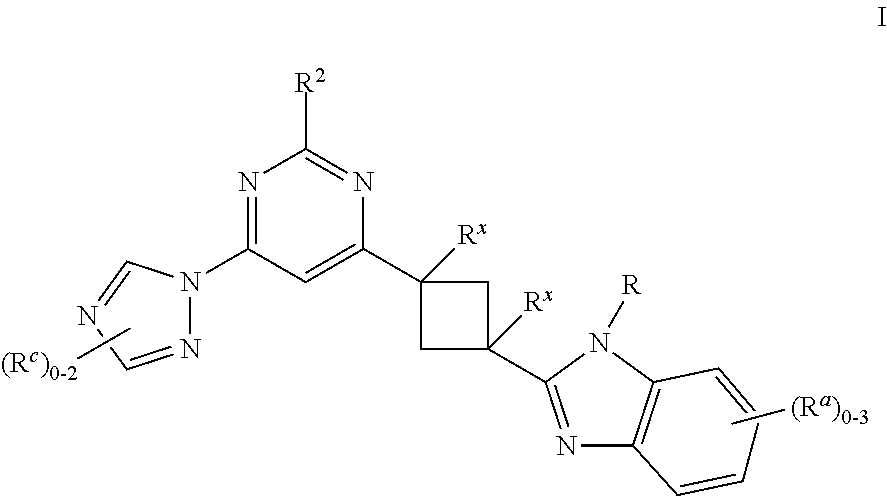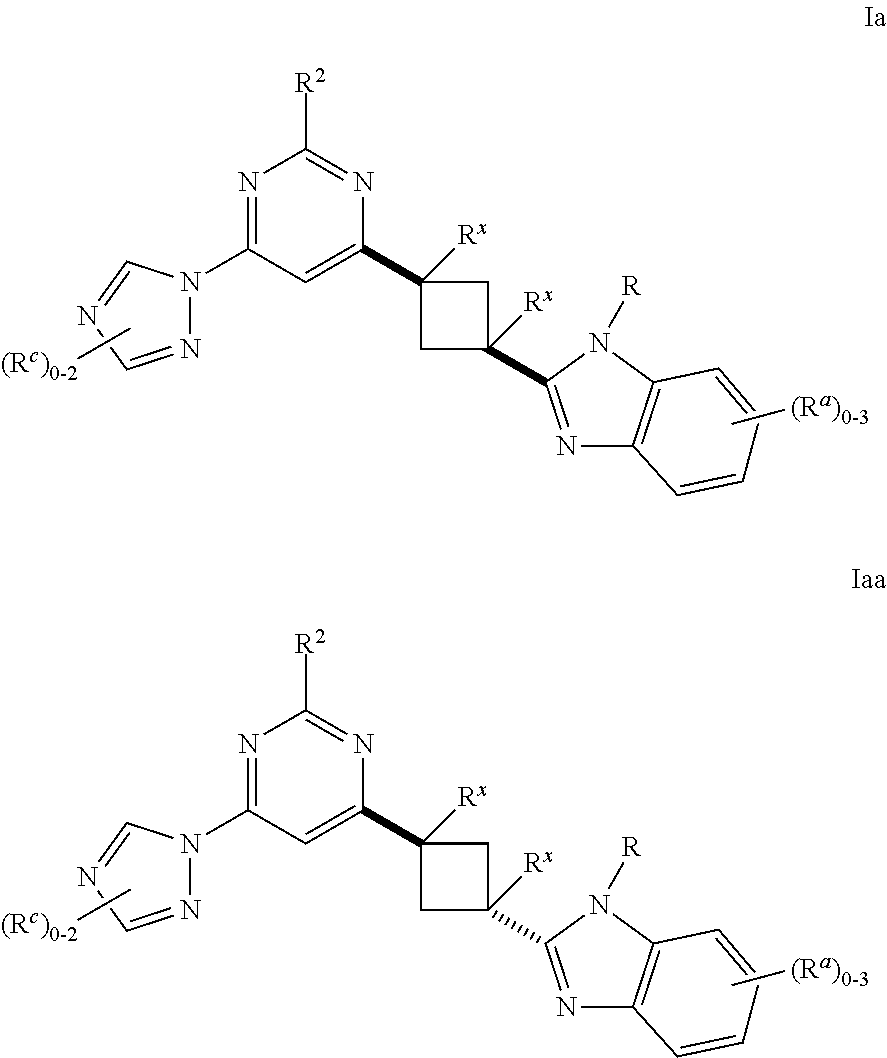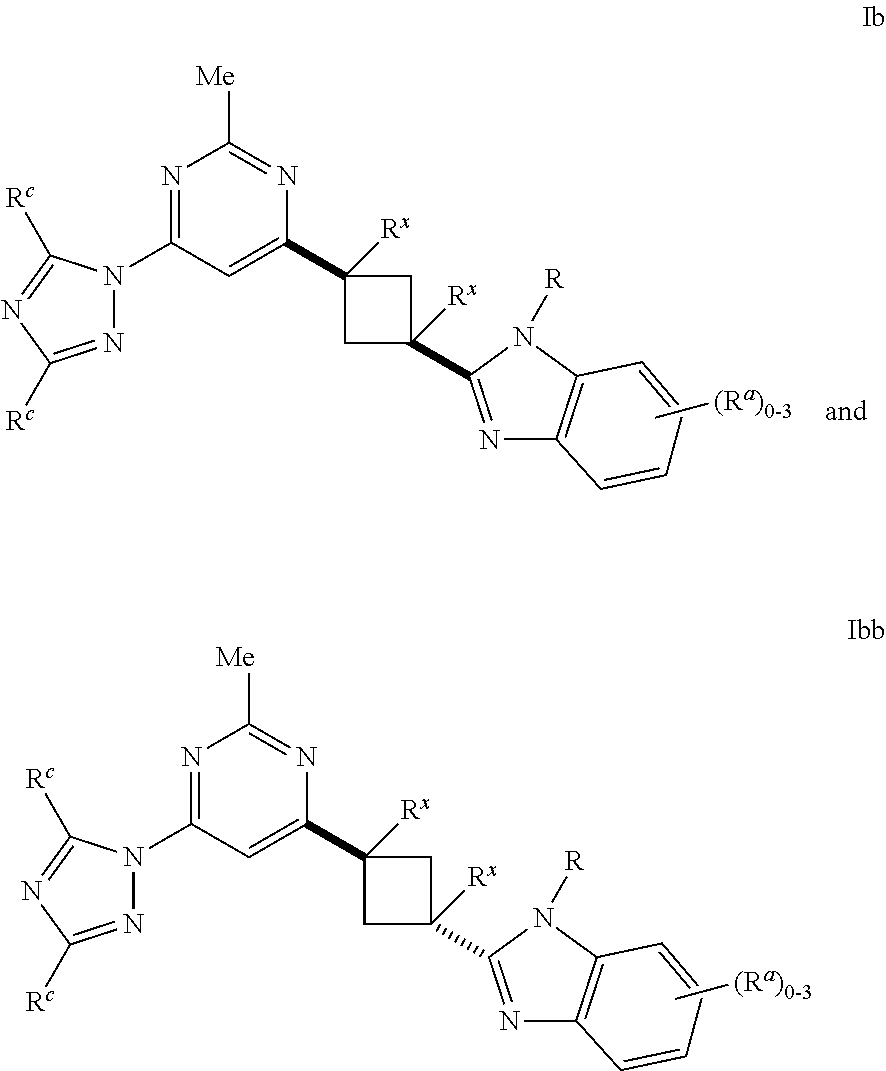Cyclobutyl benzimidazoles as PDE 10 inhibitors
a technology of cyclobutyl benzimidazoles and inhibitors, which is applied in the field of compounds, can solve the problems of high noncomplicance or discontinuation rate of medications, lack of efficacy, and dissatisfaction with therapy
- Summary
- Abstract
- Description
- Claims
- Application Information
AI Technical Summary
Benefits of technology
Problems solved by technology
Method used
Image
Examples
example 1
[0123]
[0124]
1-(6-(3,5-dimethyl-1H-1,2,4-triazol-1-yl)-2-methylpyrimidin-4-yl)-3-(1-methyl-1H-benzo[d]imidazol-2-yl)cyclobutanol (1)
[0125]To a mixture of Intermediate 2 (800 mg, 2.54 mmol) and Intermediate 1 (508 mg, 2.54 mmol) in dry THF (120 mL) was added n-BuLi (2.24 mL, 5.6 mmol, 2.5 M in toluene) dropwise at −100° C. After stirring for 30 min, the mixture was allowed to slowly warm to room temperature. The reaction was quenched with a saturated NH4Cl solution (20 mL) and the mixture was extracted with EtOAc (3×20 mL). The combined organic layer was washed with brine, dried over Na2SO4, filtered, and concentrated. The crude residue was purified on silica gel chromatography (1 / 1, Pet Ether / EtOAc) to give Example 1 as a white solid. 1H NMR (400 MHz, CD3OD) δ 7.96-7.81 (m, 3H), 7.74-7.60 (m, 2H), 4.69-4.52 (m, 1H), 4.05 (s, 3H), 3.51-3.34 (m, 4H), 2.91 (s, 3H), 2.55 (s, 3H), 2.41 (s, 3H). MS: m / z=390.2 (M+H).
example 2
[0126]
[0127]
2-(3-(6-(3,5-dimethyl-1H-1,2,4-triazol-1-yl)-2-methylpyrimidin-4-yl)-3-fluorocyclobutyl)-1-methyl-1H-benzo[d]imidazole (Example 2)
[0128]To a solution of Example 1 (20 mg, 0.051 mmol) in dry CH2Cl2 (2 mL) was added DAST (16 mg, 0.102 mmol) at −78° C. The solution was allowed to warm to room temperature over 1 h at which time LCMS indicated the reaction was complete. The reaction mixture was concentrated and the crude residue was purified by reverse-phase chromatography (5-30% MeOH / H2O) to give Example 2 as a white solid. 1H NMR (400 MHz, CD3OD) δ 7.96-7.86 (m, 3H), 7.74-7.60 (m, 2H), 4.69-4.52 (m, 1H), 4.05 (s, 3H), 3.51-3.34 (m, 4H), 2.91 (s, 3H), 2.55 (s, 3H), 2.41 (s, 3H). MS: m / z=392.2 (M+H).
examples 3 and 4
[0129]
[0130]
O-(1-(6-(3,5-dimethyl-1H-1,2,4-triazol-1-yl)-2-methylpyrimidin-4-yl)-3-(1-methyl-1H-benzo[d]imidazol-2-yl)cyclobutyl)O-phenyl carbonothioate (3-1)
[0131]To a solution of 1-(6-(3,5-dimethyl-1H-1,2,4-triazol-1-yl)-2-methylpyrimidin-4-yl)-3-(1-methyl-1H-benzo[d]imidazol-2-yl)cyclobutanol (200 mg, 0.51 mmol) in dry THF (2 mL) was added NaH (30 mg, 0.750 mmol) at 0° C. After warming the reacion to room temperature over 30 min, phenyl thionochloroformate (120 mg, 0.750 mmol) was added dropwise and the mixture was stirred for 2 h. The reaction was partitioned between EtOAc and water and extracted with EtOAc (2×20 mL). The combined organic layer was washed with brine, dried over Na2SO4, filtered, and concentrated to give the crude product that was used without further purification (260 mg, 97%). MS: m / z=526.1 (M+H).
2-(3-(6-(3,5-dimethyl-1H-1,2,4-triazol-1-yl)-2-methylpyrimidin-4-yl)cyclobutyl)-1-methyl-1H-benzo[d]imidazole (Example 3 and 4)
[0132]A mixture of 3-1 (60 mg, 0.114 mmo...
PUM
| Property | Measurement | Unit |
|---|---|---|
| temperature | aaaaa | aaaaa |
| temperature | aaaaa | aaaaa |
| temperature | aaaaa | aaaaa |
Abstract
Description
Claims
Application Information
 Login to View More
Login to View More - R&D
- Intellectual Property
- Life Sciences
- Materials
- Tech Scout
- Unparalleled Data Quality
- Higher Quality Content
- 60% Fewer Hallucinations
Browse by: Latest US Patents, China's latest patents, Technical Efficacy Thesaurus, Application Domain, Technology Topic, Popular Technical Reports.
© 2025 PatSnap. All rights reserved.Legal|Privacy policy|Modern Slavery Act Transparency Statement|Sitemap|About US| Contact US: help@patsnap.com



